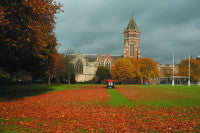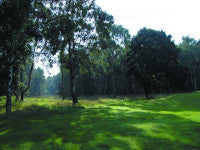Trees versus Turf...
 Trees have many functions on a golf course. Despite the reality that trees on the course can cause increased management problems for superintendents they are a vital component of a golf course. Trees on the course have many functions including:
Trees have many functions on a golf course. Despite the reality that trees on the course can cause increased management problems for superintendents they are a vital component of a golf course. Trees on the course have many functions including:
• Define fairways, aiding the line of play
• Divide fairways
• Delineate out-of-bounds areas
• Increase the challenge of a course
• Guard greens
• Act as markers for finding balls
• Complement the character of a course
• Shield from the outside world - privacy
• Add to the aesthetics of a course
• Enhance the biodiversity value of a course
• Provide wind breaks and shade
• Display a micro climate for many species
• Support the food web for many creatures
Trees and turf require many of the same conditions, however, there are also some conflicting requirements too. Trees and turf both require sunlight, water and some basic nutrients. However, competition often occurs for these requirements causing either the tree or the turf to suffer. Furthermore, maintenance requirements differ between trees and turf.
Trees and turf require different fertiliser programmes at different times. We want to see lush green grass on the course and also the shelter and visibility of majestic healthy trees.
Brushcutters and mowers can easily wound trees and also gash roots which appear near the surface, leaving them susceptible to decay and affecting tree stability. Trees also result in leaf litter and organic matter accumulation which can cause thatch problems in the turf, and the removal of fallen leaves increases the work load. Areas that are out of the way and not required to be as manicured can have leaves left where they fall.
This reduces the amount of waste being generated, allows nutrients to be returned to the ground and reduces the amount of labour required to manage the course. What leaves are going to be removed can be composted along with grass clippings and vegetation trimmings.
Several factors influence turfgrass performance including:
• Light
• Air movement
• Shade
• Water
• Nutrients
If light levels are reduced, then plant growth and performance are reduced, because the shorter light wavelengths which promote short strong growth are blocked and replaced with longer light wavelengths which give rise to long spindly growth within the turf sward.
Tree planting surrounding golf greens should be carried out in a very careful manner, as problems with shading and lack of morning sun can occur in future years. Morning sun is essential to ensure good turfgrass health and it is difficult to maintain high performing golf greens without it.
Air movement has a very strong affect on turfgrass quality, particularly in relation to grass susceptibility to disease. Many diseases thrive in conditions of poor air movement, because the air becomes stagnant and provides the disease pathogens with perfect conditions to flourish in terms of temperature and moisture under the shaded micro climates created by the tree. Turf colonises the top layers of soil more aggressively than trees, which also like to have roots in this layer, as there will ultimately be less air available deeper in the soil system.
Shade in turf leads to shorter roots and reduced root density along with reduced wear tolerance. Shade from trees contributes to turf health and reduces the amount of sunlight available and this shade from trees can lead to stress within the turf. Poorly drained shaded areas will result in the establishment of moss in the turfgrass - again increasing the competition in the sward. Shade and poor drainage conditions often results in the colonisation of mosses, particularly the trailing mosses.
Competition for nutrients and water with young trees often results in turfgrass out-competing the young trees, causing stunted growth and amplified stress levels, therefore leading to increased susceptibility to disease.
Irrigation required for turf in hot weather can accumulate at the base of a tree giving rise to rot in the system over time. Herbicides required for turfgrass management can cause damage to trees. While the generally higher rates of fertilisation required for trees will burn turf, the lower rates required for turf will have little effect for the trees.
Management strategies
There are many management strategies that can help in the association of trees and turf. These strategies can include the following:
• Use mulch, where possible, under trees instead of turf, which mimics the trees natural environment in nature. This will eliminate competition for nutrients and light and will simplify fertilisation requirements in the area.
• Shade tolerant varieties of turf can be planted around trees if required.
• Slow release fertiliser for trees helps avoid burning of the turf.
• Reduce competition for light, water and nutrients and ensure good drainage circumstances and optimal aeration conditions in the rootzone.
• Water deeply and infrequently instead of little and often where possible.
• The presence of weeds in the turf will increase competition for nutrients, so control weeds.
• Other wildflowers (for example camomile) can be used under trees instead of turf where appropriate.
Having said all this, with careful management, it is possible for healthy turf and healthy trees to co-exist and, indeed, should associate together with a balanced management plan. Understanding the management conflicts is important. Awareness of this issue is a major step towards creating a management strategy to optimise both turfgrass and trees within the ecosystem, which is the golf course. There is nothing more uplifting on a round of golf than the view of a fairway framed with majestic trees, creating a completely unique three dimensional component to a course.
About the Author: Mary Purcell is carrying out research for a doctorate degree at University College Dublin in the School of Architecture, Landscape and Civil Engineering. Contact Mary at mary.purcell@ucd.ie
